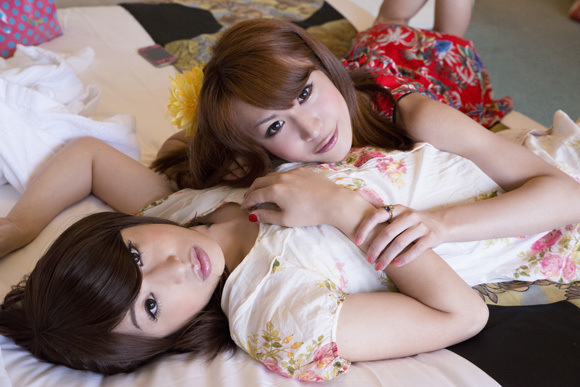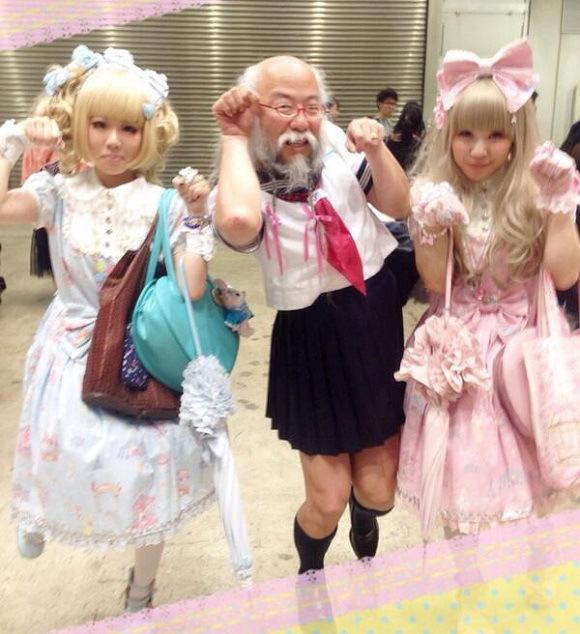
Crossdressing and genderbending are not only long-time staples of Japanese anime and manga, but also of TV and celebrity culture. From this, anyone would think that Japan was one of the most open and accepting countries when it comes to people who don’t fit into traditional gender roles or relationships. However, the reality outside of media and entertainment is often quite different. Family and work life are both still clearly divided down gender lines, and men who engage in anything that blurs or crosses these lines are generally shunned. But could the girl who dumps a guy just because he turns up to a date in a dress be the one who’s really missing out?
The recent announcement of the divorce of Japanese power couple actress Miho Nakayama and her writer/director husband Hitonari Tsuji has set tongues in the celebrity gossip blogosphere wagging, not least because one of the reasons for their split is rumored to be that Tsuji’s wife was not happy when he began to adopt a more feminine look, including growing his hair long and painting his nails. Spurred on by this, an article on dot.asahi has interviewed people quick to come to the defense of relationships where the man steps outside of traditional images of masculinity.
Terms such as transgendered and transvestite have loaded meanings in English that don’t always correlate with Japanese views, so in this case we’ll be using the Japanese term ‘otoko no ko‘. The terms otoko no ko and josoushi are used to describe a man who dresses like, and sometimes also lives like, a woman. Otoko no ko has the same reading as the word for ‘boy’ (男の子), but in this case the final kanji character is replaced with the one for ‘daughter’ (男の娘), which changes the meaning.
According to Naoko Tachibana, the otoko no ko boom began around 2009 and continues to grow with the launch of makeup magazines and salons catering specifically to them. It’s certainly true that companies have been scrambling to get their fingers in the pie of this niche market with all kinds of unnecessary products!
Naoko is a photographer and author of otoko no ko photobook Yuri Danshi, and she sees between 20 and 30 crossdressers in her studio every month. As such, she has plenty of opportunities to find out about the love lives of these guys, and apparently they’re doing pretty well for themselves. She says that women are attracted to them because they have ‘the cuteness and beauty of a woman’, but the contrast with their still very much intact ‘maleness’ is exciting. It’s also fun for girls to dress them up like a doll, putting makeup on them and choosing clothes for them.
Of course, a man will not necessarily be aware of his own inclinations when he marries, and it may only be years later that he ‘awakens’ to it. According to Naoko, ‘there are three times in a man’s life when he might awaken to the fact that he enjoys women’s clothing. First is puberty, the next is in his 30s/40s, and finally in his 60s after retirement. At times when the role expected of a man in society and the household changes, they can experience a ‘gender crisis’.’
▼ Never too old.
Unfortunately, due to societal pressure to conform, many men will keep it to themselves, which couples counselor Mariko Murakoshi says leads to much anxiety. She points out that there are plenty of sporty and androgynous women out there, so why shouldn’t there be men who enjoy more feminine styles. She also believes that women can find lots to love in a softer kind of man who shares their world view, rather than the stereotypical domineering husband. And not only that, but they’ll be able to go clothes and makeup shopping together! Unless of course she’s actually a tomboy…
Naoko agrees with Mariko that the key is to be open, and insists that ‘couples where the woman approves of her man being an otoko no ko are long-lasting! Since learning that you enjoy wearing women’s clothing isn’t something you can just ‘grow out of’, you shouldn’t hide it. I have seen many couples whose bonds have been strengthened by accepting this.‘
While this article is overly sugary and fails to address the many fears and worries that not only the otoko no ko themselves but also their partners must face, it’s refreshing to hear people talking positively about something that most of Japanese society still doesn’t really know how to deal with.
Source: Jin115
Images: Naoko Tachibana, Twitter


 a
a Japan’s latest anti-piracy ad features wacky new mascots Popcorn Otoko and Soda Otoko
Japan’s latest anti-piracy ad features wacky new mascots Popcorn Otoko and Soda Otoko “We don’t want to be girls. We just want to be cute!” The future of crossdressing in Osaka
“We don’t want to be girls. We just want to be cute!” The future of crossdressing in Osaka Elegant new bar and club space especially for crossdressers to open in Tokyo
Elegant new bar and club space especially for crossdressers to open in Tokyo Yaoi fans rejoice as Shinto shrine seems to open part-time positions for male shrine maidens
Yaoi fans rejoice as Shinto shrine seems to open part-time positions for male shrine maidens McDonald’s new Happy Meals offer up cute and practical Sanrio lifestyle goods
McDonald’s new Happy Meals offer up cute and practical Sanrio lifestyle goods All-you-can-drink Starbucks and amazing views part of Tokyo’s new 170 meter-high sky lounge
All-you-can-drink Starbucks and amazing views part of Tokyo’s new 170 meter-high sky lounge More foreign tourists than ever before in history visited Japan last month
More foreign tourists than ever before in history visited Japan last month Beautiful Sailor Moon manhole cover coasters being given out for free by Tokyo tourist center
Beautiful Sailor Moon manhole cover coasters being given out for free by Tokyo tourist center Starbucks reopens at Shibuya Scramble Crossing with new look and design concept
Starbucks reopens at Shibuya Scramble Crossing with new look and design concept Arrest proves a common Japanese saying about apologies and police
Arrest proves a common Japanese saying about apologies and police The oldest tunnel in Japan is believed to be haunted, and strange things happen when we go there
The oldest tunnel in Japan is believed to be haunted, and strange things happen when we go there Studio Ghibli glasses cases let anime characters keep an eye on your spectacles
Studio Ghibli glasses cases let anime characters keep an eye on your spectacles Tokyo luxury hotel offers month-long stays with free breakfasts, might be cheaper than apartment
Tokyo luxury hotel offers month-long stays with free breakfasts, might be cheaper than apartment Disney princesses get official manga makeovers for Manga Princess Cafe opening in Tokyo
Disney princesses get official manga makeovers for Manga Princess Cafe opening in Tokyo We try out “Chan Ramen”, an underground type of ramen popular in the ramen community
We try out “Chan Ramen”, an underground type of ramen popular in the ramen community Beautiful new Final Fantasy T-shirt collection on the way from Uniqlo【Photos】
Beautiful new Final Fantasy T-shirt collection on the way from Uniqlo【Photos】 Foreign English teachers in Japan pick their favorite Japanese-language phrases【Survey】
Foreign English teachers in Japan pick their favorite Japanese-language phrases【Survey】 Is the new Shinkansen Train Desk ticket worth it?
Is the new Shinkansen Train Desk ticket worth it? There’s a park inside Japan where you can also see Japan inside the park
There’s a park inside Japan where you can also see Japan inside the park Japanese convenience store packs a whole bento into an onigiri rice ball
Japanese convenience store packs a whole bento into an onigiri rice ball Studio Ghibli releases Kiki’s Delivery Service chocolate cake pouches in Japan
Studio Ghibli releases Kiki’s Delivery Service chocolate cake pouches in Japan Japan’s bone-breaking and record-breaking roller coaster is permanently shutting down
Japan’s bone-breaking and record-breaking roller coaster is permanently shutting down New definition of “Japanese whiskey” goes into effect to prevent fakes from fooling overseas buyers
New definition of “Japanese whiskey” goes into effect to prevent fakes from fooling overseas buyers Foreign passenger shoves conductor on one of the last full runs for Japan’s Thunderbird train
Foreign passenger shoves conductor on one of the last full runs for Japan’s Thunderbird train Our Japanese reporter visits Costco in the U.S., finds super American and very Japanese things
Our Japanese reporter visits Costco in the U.S., finds super American and very Japanese things Kyoto bans tourists from geisha alleys in Gion, with fines for those who don’t follow rules
Kyoto bans tourists from geisha alleys in Gion, with fines for those who don’t follow rules Studio Ghibli unveils Mother’s Day gift set that captures the love in My Neighbour Totoro
Studio Ghibli unveils Mother’s Day gift set that captures the love in My Neighbour Totoro Domino’s Japan now sells…pizza ears?
Domino’s Japan now sells…pizza ears? New Japanese KitKat flavour stars Sanrio characters, including Hello Kitty
New Japanese KitKat flavour stars Sanrio characters, including Hello Kitty Sales of Japan’s most convenient train ticket/shopping payment cards suspended indefinitely
Sales of Japan’s most convenient train ticket/shopping payment cards suspended indefinitely Sold-out Studio Ghibli desktop humidifiers are back so Totoro can help you through the dry season
Sold-out Studio Ghibli desktop humidifiers are back so Totoro can help you through the dry season Japanese government to make first change to romanization spelling rules since the 1950s
Japanese government to make first change to romanization spelling rules since the 1950s Ghibli founders Toshio Suzuki and Hayao Miyazaki contribute to Japanese whisky Totoro label design
Ghibli founders Toshio Suzuki and Hayao Miyazaki contribute to Japanese whisky Totoro label design Doraemon found buried at sea as scene from 1993 anime becomes real life【Photos】
Doraemon found buried at sea as scene from 1993 anime becomes real life【Photos】 Tokyo’s most famous Starbucks is closed
Tokyo’s most famous Starbucks is closed One Piece characters’ nationalities revealed, but fans have mixed opinions
One Piece characters’ nationalities revealed, but fans have mixed opinions We asked a Uniqlo employee what four things we should buy and their suggestions didn’t disappoint
We asked a Uniqlo employee what four things we should buy and their suggestions didn’t disappoint Princesses, fruits, and blacksmiths: Study reveals the 30 most unusual family names in Japan
Princesses, fruits, and blacksmiths: Study reveals the 30 most unusual family names in Japan Studio Ghibli’s new desktop Howl’s Moving Castle will take your stationery on an adventure
Studio Ghibli’s new desktop Howl’s Moving Castle will take your stationery on an adventure Japanese town’s mascot character may be a man dressed in women’s clothing, possibly on purpose
Japanese town’s mascot character may be a man dressed in women’s clothing, possibly on purpose How drunk can Awamori Jelly infused with liquor from Okinawa make us?
How drunk can Awamori Jelly infused with liquor from Okinawa make us? YouTuber lists the “10 types of Japanese men” as according to Japanese women
YouTuber lists the “10 types of Japanese men” as according to Japanese women Nearly one in four Japanese adults admits to crying in the office bathroom in new survey
Nearly one in four Japanese adults admits to crying in the office bathroom in new survey Our reporter heads to an all-male crossplay event, and the results are gorgeous
Our reporter heads to an all-male crossplay event, and the results are gorgeous We copy the look of Matt, Japan’s hottest male model as SoraNews24’s Meg becomes Mett
We copy the look of Matt, Japan’s hottest male model as SoraNews24’s Meg becomes Mett Japanese high school boy wows netizens with his cute girl-next-door looks
Japanese high school boy wows netizens with his cute girl-next-door looks The upside of dating a man whose hobby is joso, or cross-dressing as a woman【Interview】
The upside of dating a man whose hobby is joso, or cross-dressing as a woman【Interview】 Woman in short skirt arrested after inciting upskirt photography in Tokyo
Woman in short skirt arrested after inciting upskirt photography in Tokyo Four things women are banned from doing in Japan【Women in Japan Series】
Four things women are banned from doing in Japan【Women in Japan Series】 Is it OK for men cosplaying as women to use the women’s restroom in Japan? Twitter debates
Is it OK for men cosplaying as women to use the women’s restroom in Japan? Twitter debates Japanese men reveal the things they notice when they see a woman without makeup
Japanese men reveal the things they notice when they see a woman without makeup Our male Japanese-language reporter gets a professional makeover, becomes pretty cheerleader
Our male Japanese-language reporter gets a professional makeover, becomes pretty cheerleader
Leave a Reply